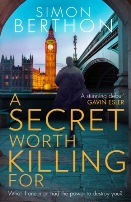 In today’s weird world, the question is more pertinent that
ever. Trump, nerve agents beside a
sleepy English cathedral close, Jacob Rees-Mogg touted as the next Tory leader
- reality or, perhaps, the uber-reality of manipulation and fake news that has
superseded it, often seem far stranger than any conceivable fiction. To me,
that’s the point. I’m fed up with fakery and simplistic raucousness; maybe
fiction’s the route to authenticity.
In today’s weird world, the question is more pertinent that
ever. Trump, nerve agents beside a
sleepy English cathedral close, Jacob Rees-Mogg touted as the next Tory leader
- reality or, perhaps, the uber-reality of manipulation and fake news that has
superseded it, often seem far stranger than any conceivable fiction. To me,
that’s the point. I’m fed up with fakery and simplistic raucousness; maybe
fiction’s the route to authenticity.
My starting point is not that anything I write did or will
happen; but that it is feasible and credible in the real world I know from my
own experience that it could have or could happen. The kick I get is that the
ability to manipulate and invent stories and characters makes for a level of
intrigue and excitement that fact can get in the way of, while remaining rooted
in reality. It is a liberation, even if beginning with a blank page makes the
writing so much harder.
The ‘front’ story of my novel, A Secret Worth Killing For,
is set in the weeks following a UK general election in May 2017. When I wrote
it, I had no idea there would be an actual election just a month later than that,
only that there was no reason why there shouldn’t be. (Mind you, the June 2017
election’s initial trigger - the Brexit result a year earlier and resignation
of one Prime Minister - and its outcome - the self-immolation of his successor
- certainly seemed stranger than fiction.)
My election was won - though I felt no need for this to be
overtly stated - by a victor that resembles a soft-left Labour party led by a
mid-Milibandite leader. It had to be this way because my lead character (I
hesitate to call her heroine as she is more slippery than that), Anne-Marie
Gallagher, could never have been a Tory.
My ‘back’ story takes place in Ireland between 1991 - 1994.
I worked in Northern Ireland as an investigative documentary maker for the BBC
and ITV, though in a period a short while before that. I placed my ‘back’ story
a few years later than my own time in Belfast for two reasons. Firstly, the
chronology which needed to put Anne-Marie in her mid-forties in 2017 meant she
had to be a teenager in the early 1990s. Secondly, I didn’t want to write about
the precise time I was living in Ireland to avoid one risk of slipping into
literalism.
I did, however, want to write about how the troubles could
cast a shadow decades later over people who became public figures but had
skeletons in their closets. In the world of fact, the most well-known of these
have been Gerry Adams and Martin McGuinness, but I wasn’t interested in writing
about them or anyone like them. Instead I wanted to use the freedom of fiction
to cast an attractive, beguiling woman at the heart of my story who was lured
into something bad and would end up being betrayed by a different type of
jeopardies. Anne-Marie was originally drawn in part from personal experience -
a composite of women I’d known in Northern Ireland (I should add that none of
them went through anything like her experiences!). However, I found that by the
end of the novel she had become, to me, a fully invented character even if my
own encounters had helped to give her substance.
My experiences in Ireland gave me context and colour. During
my time, the non-stop nights of bombing were over - that was the early 1970s.
Mine was the age of the IRA’s move into one-off spectaculars: the assassination
of Lord Mountbatten in 1979 and his companions in his small fishing boat off
Mullaghmore; the killing on the same day of eighteen British soldiers in an
ambush near Warrenpoint; and then, two years later, the IRA hunger strikes in
The Maze prison. A World in Action documentary I made on the first IRA hunger
strike was the first time a film crew was allowed into the hunger strikers’
cells as they lay staring at cell walls smeared with their own excrement as a
result of the much longer-running ‘dirty protest.’ (That was something no fiction writer could
have invented.)
Behind these big events, a deeper game was being played - a
war of intelligence. I knew from conversations behind closed doors with both
paramilitaries and security forces that intelligence became the theatre where
the ‘war’ between the IRA and the Ulster police and British army would be won
and lost. Placing agents at the heart of the IRA was the one way to undermine
them and persuade the leadership that they could never win a ‘military’
conflict; even more powerfully, it showed they were in real danger of defeat.
It was against this background that a second element in my
‘back’ story, the peace feelers in the early 1990s between the IRA and the
British government, were set in motion. More than ever before, intelligence was
needed, leading, in A Secret Worth Killing For, to a lethal game in
which the young Anne-Marie (then called Maire) was a pawn, manipulated by
characters on different sides from whom she risked both exposure and betrayal.
An important part of my story is that the teenage Maire
undergoes a reinvention, deploying a variety of means, that culminates in her,
under her changed name, becoming an MP and junior government minister 25 years
later. That was the part of the narrative where I had to apply myself most
acutely to the question of whether it was feasible or credible. If the teenage
‘Maire’ had been living in today’s world, the answer is probably not. The world
of twenty-five years ago was very different. The internet was in its infancy;
there was no digital storage of records - a person’s history could be excised
by the tearing up of a piece of paper; the mobile phone was also in its infancy
(no-one born later than the early 1980s could ever imagine those big black
phones that used to be carried around); there were no biometrical records, no
systemic facial recognition technology.
Therefore with the expert help and protection the young
Maire is given (plot spoiler to give those away), this reinvention passed my
two tests. In addition, anyone familiar with the real case of Agent Stakeknife
will know that intelligence agencies will, if there’s the need, protect
operations and assets over decades, not just years.
Twenty-five years on, when Anne-Marie becomes a public
figure in today’s changed world, it only takes days for the ghosts of her past
to begin to catch up. But the reason has nothing to do with the paraphernalia
of surveillance technology, digital storage, social media etc which are usually
paraded as the dominant forces of today’s society. Instead it is much simpler
and, for me, more satisfying.
Anne-Marie had made one very human mistake. There was still
someone out there who she’d calculated had no right to be.

HQ - First edition edition £7.99 (3 May 2018)